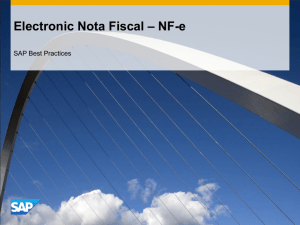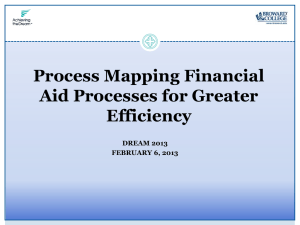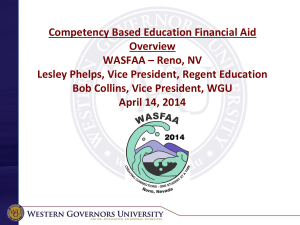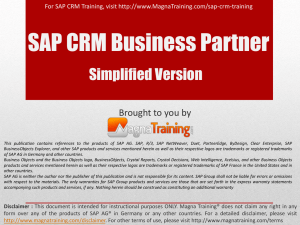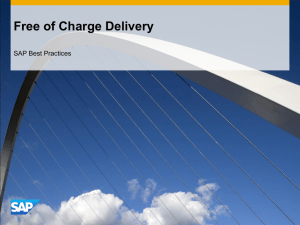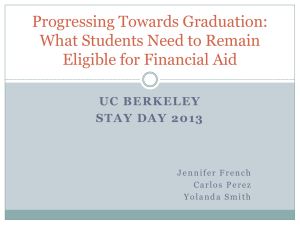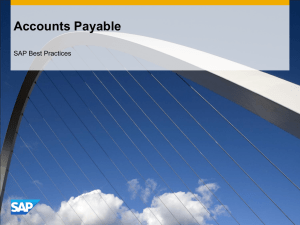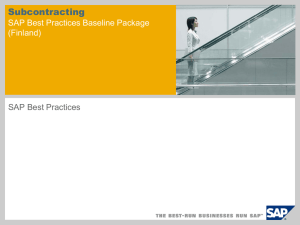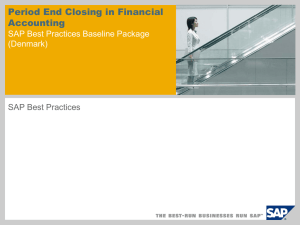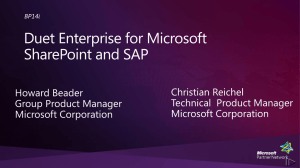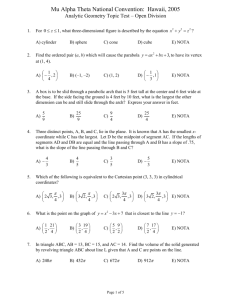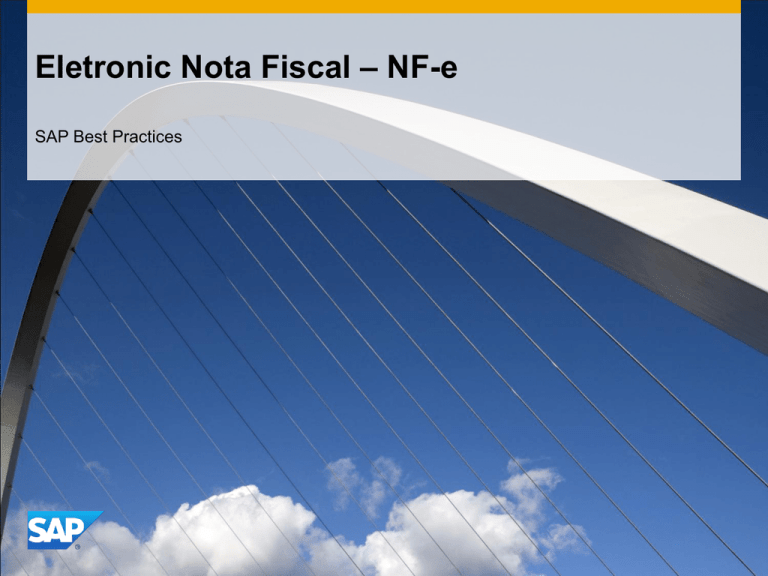
Eletronic Nota Fiscal – NF-e
SAP Best Practices
Purpose, Benefits, and Key Process Steps
Objetivo
This scenario describes the processes of Electronic Nota Fiscal for:
1.
2.
3.
4.
Electronic Nota Fiscal Cancel
Switched or Posted under Contingency
2.1 NF-e Switched to Contingency – NF-e Writer
2.2 NF-e Switched to Contingency (Only Cancel) – MM
2.3 NF-e Switched to Contingency – SD
2.4 NF-e Posted Under Contingency
Electronic Nota Fiscal Skipping
Electronic Nota Fiscal Gap’s Skipping
Benefits
Monitoring process / action of users in the processes generated by failure of
communication with the SEFAZ or Gaps occurred during the execution of procedures
© 2011 SAP AG. All rights reserved.
2
Required SAP Applications and Company Roles
Required SAP Applications
Enhancement package 5 for SAP ERP 6.0
Company Roles
Employee (Brazil Localization)
Warehouse Clerk
IT Administrator
© 2011 SAP AG. All rights reserved.
3
Detailed Process Description
Electronic Nota Fiscal
This scenario describes the possible processes that are required for the output Nota
Fiscal in Contingency (when there are communication problems with the SEFAZ) and
possible Gap’s that may occur during procedures to output NF-e.
The procedures are differentiated as follows:
Electronic Nota Fiscal Cancel: The cancelation of Electronic Nota Fiscal occurs when you have
the authorization from SEFAZ, but for any reason, you have to cancel the Electronic Nota Fiscal.
In this moment, the company has to create a Request for Cancel NF-e (XML) sending to SEFAZ.
NF-e Switched to Contingency – NF-e Writer: The Nota Fiscal Electronic Switched to
Contingency occurs when there is a urgency to issue the electronic Nota Fiscal but has not a
quick answer from SEFAZ, (E.g. communication error or slow response time from SEFAZ), then
the user switch the NF-e to contingency and create a new NF-e that must be printed with security
form.
NF-e Switched to Contingency (Only Cancel) – MM: The Nota Fiscal Electronic Switched to
Contingency occurs when there is a urgency to issue the electronic Nota Fiscal but has not a
quick answer from SEFAZ, (E.g. communication error or slow response time from SEFAZ), then
the user switch the NF-e to contingency and print it with security form.
© 2011 SAP AG. All rights reserved.
4
Detailed Process Description
NF-e Switched to Contingency – SD : The Nota Fiscal Electronic Switched to Contingency occurs
when there is a urgency to issue the electronic Nota Fiscal but has not a quick answer from
SEFAZ, (E.g. communication error or slow response time from SEFAZ), then the user switch the
NF-e to contingency and create a new NF-e that must be printed with security form.
NF-e Posted Under Contingency: This step is necessary when the Business Place must be under
contingency (e.g. without communication, communication failed or slow response time from
SEFAZ), then the user must set the Business Place under contingency to create NF-e. Therefore
these NF-e will be printed on security form.
Electronic Nota Fiscal Skipping: The Electronic Nota Fiscal Skipping exists when a NF-e was
rejected by SEFAZ, or was rejected by the messaging system, or was rejected due existing GAP
numbering. For these situation, the company has to create a Request for NF-e (XML) Skipping to
SEFAZ.
Electronic Nota Fiscal Gap’s Skipping : The Nota Fiscal Electronic Gap’s Skipping occurs when
you have a gap on number range of NF-e. You have knowledge about gaps when you see a
number incompatible with NF-e numbers.
© 2011 SAP AG. All rights reserved.
5
Process Flow Diagram
Event
Electronic Nota Fiscal Cancel
NF-e Cancel
Employee (Brazil Localization)
Identifies the
need to cancel
an NFE
© 2011 SAP AG. All rights reserved.
Send the request
to cancel for
SEFAZ
Cancel
Approved?
No
Send the new
request to cancel
for SEFAZ
Yes
NFe Cancel
6
Process Flow Diagram
Employee (Brazil Localization) /
Warehouse Clerk
Event
Switched or Posted under Contingency
NF-e Switched
to Contingency –
NF-e Writer
NF-e Switched
to Contingency
(Only Cancel) –
MM
NF-e Switched
to Contingency –
SD
Choose the NFe
in the J1BNFE
monitor and put
in contigency
Choose the NFe
in the J1BNFE
monitor and put
in contigency
Choose the NFe
in the J1BNFE
monitor and put
in contigency
Cancel the
Original
Document
(transaction
MBST)
Cancel the
Original
Document
(transaction
VF11)
Switch the
Business Place
to Contingency
Wait for answer
SEFAZ
In Transaction
J1B3N enter the
number of doc.
Converted for
contingency
The system will
cancel the Nota
Fiscal selected
and will generate
a new NF
Contingency
Create a new NFe
NF-e Posted
Under
Contigency
Choose the NFe
in the J1BNFE
monitor and put
in contigency
Create Eletronic
Nota Fiscal in
Contigency
End
In the transaction
VF01 and with
Delivered number
make a new NF-e
Posted under
Contingency.
End
© 2011 SAP AG. All rights reserved.
End
End
7
Process Flow Diagram
Electronic Nota
Fiscal Skipping
IT
Administrator
Event
Eletronic Nota Fiscal Skipping
Electronic Nota
Fiscal Gap’s
Skipping
In transaction SE38, execute the
program
J_1BNFECHECKNUMBERRANGE
S
Employee (Brazil Localization)
In the transaction
ZNFENUMGAPS
check the status for
request
In transaction
J1BNFE choose
the NFe rejected
by SEFAZ
Status 1 or
2?
Entry with the
Reason of Cancel
and request the
cancel for SEFAZ
Receive
confirmation of
SEFAZ
End
© 2011 SAP AG. All rights reserved.
2
Use the transaction
ZNFENUMCHECK to
adjust the numbers
and new send
skipping request for
SEFAZ
1
Numbering of
Eletronic Nota
Fiscal Skipping
End
8
Legend
<Function>
Symbol
Description
Usage Comments
Band: Identifies a user role, such as Accounts
Payable Clerk or Sales Representative. This band
can also identify an organization unit or group,
rather than a specific role.
Role band contains
tasks common to that
role.
Symbol
Diagram
Connection
The other process flow symbols in this table go
into these rows. You have as many rows as
required to cover all of the roles in the scenario.
External
to SAP
External Events: Contains events that start or end
the scenario, or influence the course of events in
the scenario.
Business
Activity / Event
Unit Process
Process
Reference
SubProcess
Reference
Process
Decision
Usage Comments
To next / From last Diagram: Leads
to the next / previous page of the
Diagram
Flow chart continues on the next /
previous page
Hardcopy / Document: Identifies a
printed document, report, or form
Does not correspond to a task
step in a document; instead, it is
used to reflect a document
generated by a task step; this
shape does not have any outgoing
flow lines
Financial Actuals: Indicates a
financial posting document
Does not correspond to a task
step in a document; instead, it is
used to reflect a document
generated by a task step; this
shape does not have any outgoing
flow lines
Budget Planning: Indicates a
budget planning document
Does not correspond to a task
step in a document; instead, it is
used to reflect a document
generated by a task step; this
shape does not have any outgoing
flow lines
Manual Process: Covers a task
that is manually done
Does not generally correspond to
a task step in a document;
instead, it is used to reflect a task
that is manually performed, such
as unloading a truck in the
warehouse, which affects the
process flow.
Existing Version / Data: This block
covers data that feeds in from an
external process
Does not generally correspond to
a task step in a document;
instead, this shape reflects data
coming from an external source;
this step does not have any
incoming flow lines
System Pass / Fail Decision: This
block covers an automatic
decision made by the software
Does not generally correspond to
a task step in the document;
instead it is used to reflect an
automatic decision by the system
that is made after a step has been
executed.
Hardcopy /
Document
Flow line (solid): Line indicates the normal
sequence of steps and direction of flow in the
scenario.
Flow line (dashed): Line indicates flow to
infrequently-used or conditional tasks in a
scenario. Line can also lead to documents involved
in the process flow.
Connects two tasks in
a scenario process or
a non-step event
Business Activity / Event: Identifies an action that
either leads into or out of the scenario, or an
outside Process that happens during the scenario
Does not correspond
to a task step in the
document
Unit Process: Identifies a task that is covered in a
step-by-step manner in the scenario
Corresponds to a task
step in the document
Financial
Actuals
Process Reference: If the scenario references
another scenario in total, put the scenario number
and name here.
Corresponds to a task
step in the document
Sub-Process Reference: If the scenario references
another scenario in part, put the scenario number,
name, and the step numbers from that scenario
here
Corresponds to a task
step in the document
Process Decision: Identifies a decision / branching
point, signifying a choice to be made by the end
user. Lines represent different choices emerging
from different parts of the diamond.
Does not usually
correspond to a task
step in the document;
Reflects a choice to
be made after step
execution
© 2011 SAP AG. All rights reserved.
Description
Budget
Planning
Manual
Process
Existing
Version /
Data
System
Pass/Fail
Decision
9
© 2011 SAP AG. All rights reserved
No part of this publication may be reproduced or transmitted in any form or for any purpose
without the express permission of SAP AG. The information contained herein may be
changed without prior notice.
Some software products marketed by SAP AG and its distributors contain proprietary
software components of other software vendors.
Microsoft, Windows, Excel, Outlook, and PowerPoint are registered trademarks of Microsoft
Corporation.
IBM, DB2, DB2 Universal Database, System i, System i5, System p, System p5, System x,
System z, System z10, System z9, z10, z9, iSeries, pSeries, xSeries, zSeries, eServer,
z/VM, z/OS, i5/OS, S/390, OS/390, OS/400, AS/400, S/390 Parallel Enterprise Server,
PowerVM, Power Architecture, POWER6+, POWER6, POWER5+, POWER5, POWER,
OpenPower, PowerPC, BatchPipes, BladeCenter, System Storage, GPFS, HACMP,
RETAIN, DB2 Connect, RACF, Redbooks, OS/2, Parallel Sysplex, MVS/ESA, AIX,
Intelligent Miner, WebSphere, Netfinity, Tivoli and Informix are trademarks or registered
trademarks of IBM Corporation.
Linux is the registered trademark of Linus Torvalds in the U.S. and other countries.
Adobe, the Adobe logo, Acrobat, PostScript, and Reader are either trademarks or
registered trademarks of Adobe Systems Incorporated in the United States and/or other
countries.
Oracle is a registered trademark of Oracle Corporation.
UNIX, X/Open, OSF/1, and Motif are registered trademarks of the Open Group.
Citrix, ICA, Program Neighborhood, MetaFrame, WinFrame, VideoFrame, and MultiWin are
trademarks or registered trademarks of Citrix Systems, Inc.
HTML, XML, XHTML and W3C are trademarks or registered trademarks of W3C®, World
Wide Web Consortium, Massachusetts Institute of Technology.
Java is a registered trademark of Sun Microsystems, Inc.
JavaScript is a registered trademark of Sun Microsystems, Inc., used under license for
technology invented and implemented by Netscape.
Business Objects and the Business Objects logo, BusinessObjects, Crystal Reports, Crystal
Decisions, Web Intelligence, Xcelsius, and other Business Objects products and services
mentioned herein as well as their respective logos are trademarks or registered trademarks
of Business Objects Software Ltd. Business Objects is an SAP company.
Sybase and Adaptive Server, iAnywhere, Sybase 365, SQL Anywhere, and other Sybase
products and services mentioned herein as well as their respective logos are trademarks or
registered trademarks of Sybase, Inc. Sybase is an SAP company.
All other product and service names mentioned are the trademarks of their respective
companies. Data contained in this document serves informational purposes only. National
product specifications may vary.
The information in this document is proprietary to SAP. No part of this document may be
reproduced, copied, or transmitted in any form or for any purpose without the express prior
written permission of SAP AG.
This document is a preliminary version and not subject to your license agreement or any
other agreement with SAP. This document contains only intended strategies, developments,
and functionalities of the SAP® product and is not intended to be binding upon SAP to any
particular course of business, product strategy, and/or development. Please note that this
document is subject to change and may be changed by SAP at any time without notice.
SAP assumes no responsibility for errors or omissions in this document. SAP does not
warrant the accuracy or completeness of the information, text, graphics, links, or other items
contained within this material. This document is provided without a warranty of any kind,
either express or implied, including but not limited to the implied warranties of
merchantability, fitness for a particular purpose, or non-infringement.
SAP shall have no liability for damages of any kind including without limitation direct,
special, indirect, or consequential damages that may result from the use of these materials.
This limitation shall not apply in cases of intent or gross negligence.
The statutory liability for personal injury and defective products is not affected. SAP has no
control over the information that you may access through the use of hot links contained in
these materials and does not endorse your use of third-party Web pages nor provide any
warranty whatsoever relating to third-party Web pages.
SAP, R/3, SAP NetWeaver, Duet, PartnerEdge, ByDesign, SAP BusinessObjects Explorer,
StreamWork, and other SAP products and services mentioned herein as well as their
respective logos are trademarks or registered trademarks of SAP AG in Germany and other
countries.
© 2011 SAP AG. All rights reserved.
10

